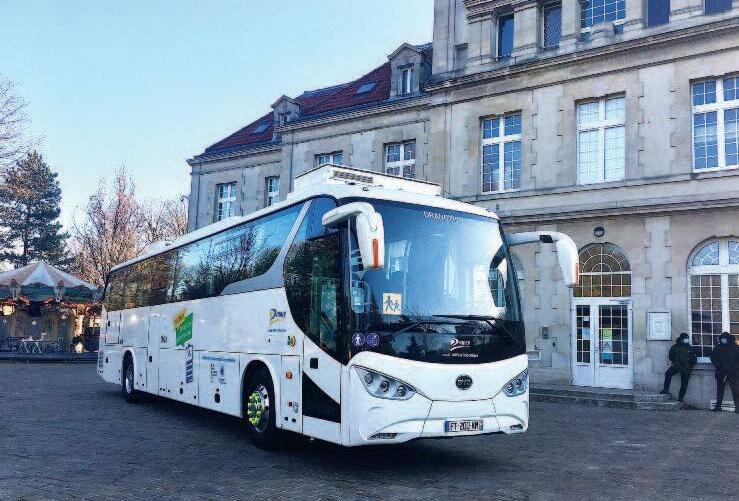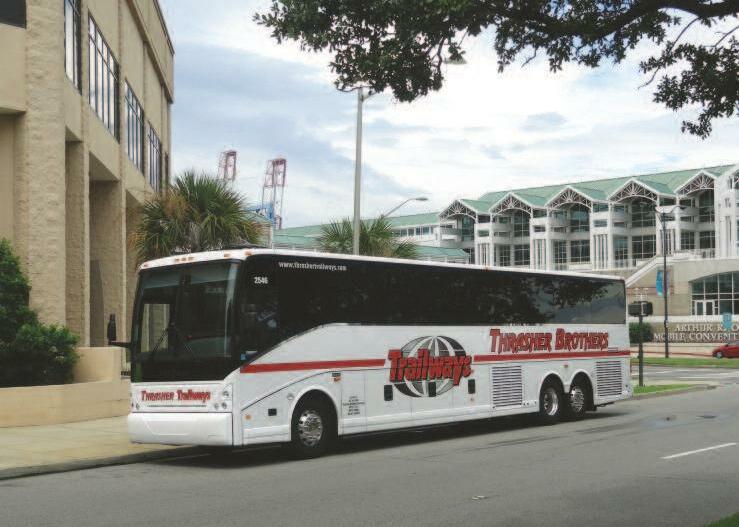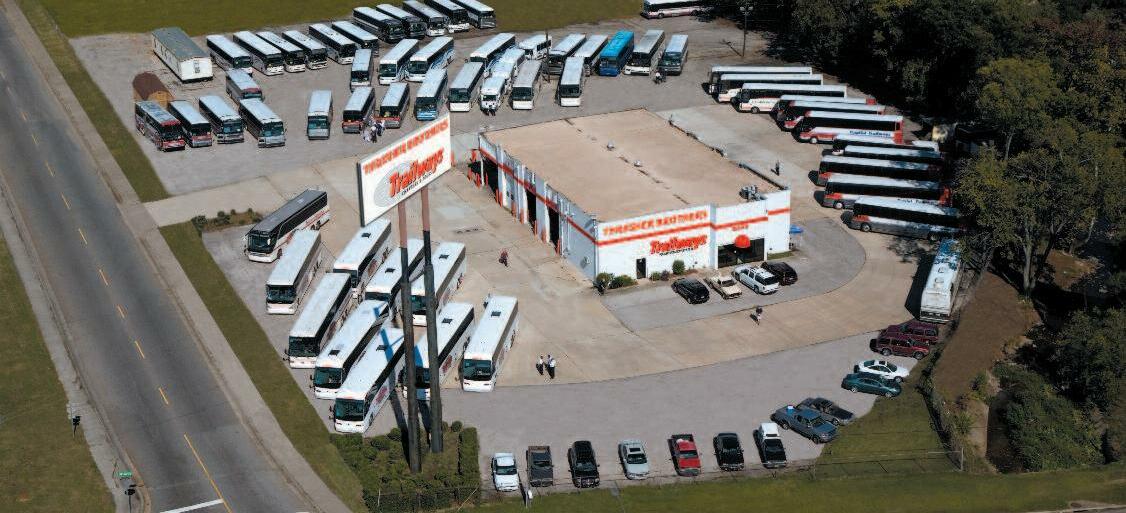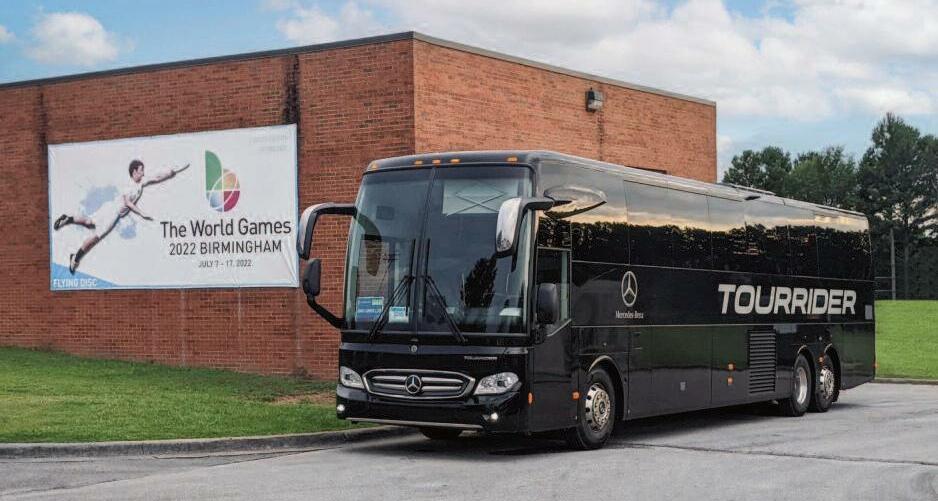
15 minute read
The New Fire Risks Associated with EVs and HEVs by Jonas Bergström
from National Bus Trader The Magazine of Bus Equipment for the United States and Canada Volume XLVI, No.1
The new fire risks associated with EVs and HEVs
How do we minimize them?
Advertisement
This new Solaris Urbano 12 electric bus was photographed in Hamburg, Germany on Ludwig-Erhard-Strasse in front of St. Michael’s Church. While electric buses may look similar to diesel buses externally, their fire hazards are substantially different. Solaris builds buses in Poland and offers a wide range of transit buses. SOLARIS.
With a growing coalition of countries pledging to reach climate change targets of net-zero emissions, the world is seeing a massive transition to renewable fuels. As a result, the automotive industry is changing to meet growing demand for electric and hybrid public transport vehicles. Jonas Bergström, business manager at Dafo Vehicle Fire Protection’s bus and coach division, assesses current and new vehicle fire risks as the automotive industry moves towards electrification, and explains how vehicle operators can minimize these risks.
Recent Developments Europe
The United Nations Economic Commission (UNECE) introduced Regulation 107 to impose stronger bus and coach safety regulations. Under these regulations, engine vehicles are legally required to have an automated fire suppression system in the engine compartment. However, UNECE Regulation 107 does not discuss the fire hazards brought about by lithium-ion batteries used in electric vehicles (EVs) or the electric component of hybrid electric vehicles (HEVs).
Currently, it is not a legal requirement for vehicles without internal combustion engines (such as EVs) to be equipped with automated fire suppression systems. The drawback of this is that, in the event of a fire, the manual extinguishing function and external system may need to operate together, which can escalate the spread of fire and increase downtime.
The latest draft of UNECE Regulation 100 (Construction and Safety of Electric Powertrains) was issued in 2020 and recommends an early warning signal in case of battery failure in rechargeable electrical energy storage systems (REESS), especially where there is risk of thermal runaway. Thermal runaway is where a battery cell defect – caused by overcharging, overheating, overvoltage or physical damage – leads to rapid temperature increases, and higher risks of potential explosions, fire and toxic gas emissions.
In order to recognize potential battery failure at the earliest possible stage and
reduce the risk of a fire, in line with Regulation 100, fire suppression systems could be used as an additional safety device to discharge a cooling agent to minimize hazardous risks. In Annex 8E, UNECE Regulation 100 recommends fire testing REESS from an external fire source.
Recent Developments in the United States
The U.S. market is very different to Europe, with various types of public vehicles, including over-the-road coaches, school buses and transit buses.
Over-The-Road Coaches
These coaches cross state lines and they are under the jurisdiction of the Department of Transportation. Currently, there is no requirement for over-the-road coaches to have anything beyond a portable fire extinguisher. Original equipment manufacturers (OEMs) make the decision to install detection and suppression systems.
After Hurricane Katrina sparked a nationwide catastrophe, insurance premiums rapidly increased. OEMs attempted to negotiate insurance discounts if coaches were fitted with a fire suppression system; however, insurance companies would not agree to discount deals. Ultimately, liability rested with the coaches for losses following a fire. Coaches are privately funded, and OEMs are not regulated by a public authority in relation to fire safety in coaches.
School Buses
There are about .5 million school buses with only a few major manufacturers. Children run practice drills on evacuation and school buses are equipped with big exit doors. The positioning of the engine is critical to detecting fire risk. Bus drivers would be able to spot smoke if the engine is positioned at the front, but if the engine is at the rear of the bus, they would not be able to spot risks as quickly.
Currently, there is no requirement for school buses to be fitted with a fire suppression system. The only requirement in Los Angeles County, however, is if school buses use alternative fuel, such as propane or liquefied petroleum gas, they need to be fitted with gas sensors.
Transit Buses
The majority of funding for transit buses comes from the government. Each transit agency is responsible for their own remit, where they decide what fire protection to use and what systems to install.
Around 10 years ago, a rail incident occurred in Washington, D.C. After an investigation, the government found issues with overall safety and gave the transit agency one year to improve its safety protocols. However, the safety protocols were not improved within the year. As a result, now, safety officers are separated from management, and they are solely responsible for ensuring health and safety on transit buses. Currently, many transit authorities, including Washington Metropolitan Area Transit Authority, are supporting the industry through finding new solutions to improve fire risk management.
The bus and coach industry is looking to move rapidly to develop and implement fire risk management, detection and suppression systems for electric vehicles. The industry is evolving in line with the growing worldwide movement to use greener fuels and reduce greenhouse gas emissions.

Shown here is a Thomas Built Saf-T-Liner C2 Jouley electric school bus. It was photographed westbound on Wacker Drive in Chicago near State Street with the Chicago River adjacent and the Wrigley Building obvious in the background. There apparently are no special fire regulations for electric school buses. THOMAS/DAIMLER.
This is the first BYD electric coach delivered in the Paris area. Electric coaches share many of the same fire safety concerns as electric transit buses. Substantial work and effort is going into finding way to make them safer. BYD.

New Fire Risks and How to Spot Them
Joey Peoples, CEO of Dafo US, and Jay Taylor, regional manager at Dafo’s Transit and Motorcoach area, believe the direction of travel for the industry is learning from mistakes and making improvements for the
future. With any new technology, fires are inevitable and there should be more focus on origin and prevention, rather than deliberating who was to blame.
As the industry adapts to make full use of greener fuels, Joey Peoples comments: “All detection and suppression systems need to communicate and work together to determine risk. We need to understand our own systems and understand how one communicates to send warning signals to alert the other to release agent.
Li-ion batteries, commonly used to fuel EVs, are at risk of thermal runaway. The most effective way to address these types of fires is by spot cooling, with early fire cooling systems localizing and mitigating thermal runaway risk.
There are new and specific challenges to overcome and new risk assessments to carry out with the introduction of EVs and HEVs in public transport.
The location is the main difference between vehicles between ICEs (internal combustion engines) and EVs or HEVs. The majority of fire sources in vehicles with ICEs are found in the engine compartment area. However, the potential fire sources can be located in different areas in EVs and HEVs, in which case, more protection zones should be put in place. Additionally, due to the sensitivity of electrical components and the types of fire that could spread in different areas of these vehicles, specific extinguishing agents may need to be used.

You might note that the engine compartment of this Solaris Urbano 12 does not have an engine because it is an electric bus. The experts will tell you that fire risks are substantially different between diesel buses and electric buses. While the engine compartment is usually the top fire hazard on a diesel bus, it is generally the battery that causes the most concern on electric buses.
BYD recently showed off a new design of 12-meter (39-foot) electric buses at the recent IAA show in Hanover, Germany in September of 2022. They also announced their safer Blade Battery. BYD has electric buses running in numerous countries and cities. BYD.
Risk Management Assessment
The Research Institutes of Sweden (RISE) published a fire risk management assessment, which can be used as guidance and includes the following steps:
1. Hazard identification 2. Risk estimation 3. Risk evaluation 4. Risk reduction.
Failure mode and effective analysis (FMEA) entails identifying hazards and then quantifying risks, so that they can be ranked according to their priority.
After the risks have been quantified, they can be listed in order of priority to provide a holistic view of the risk map. A risk map isolates risks that are deemed to be acceptable from those which need to be addressed.
Finally, an action plan for the identified fire risks can be developed with appropriate risk reduction measures, including:
1) Risk elimination or minimization by design 2) Active and passive fire protection systems 3) Improved cleaning and maintenance procedures 4) Improved quality and training procedures.
As soon as hazards are identified, priorities naturally emerge as to which risks need to be mitigated first. Consequently, the actions that follow this ensure that the automotive industry – including its many and varied users – is made safer.
To find out more about choosing a unique fire protection solution for your electric bus or coach, visit Dafo Vehicle Fire Protection. q

Celebrating 50 Years

Thrasher Brothers Keeps Growing, Building New Markets
by Pat Plodzeen
Photos courtesy of Thrasher Brothers
Four new Thrasher Setra coaches for use on a contract are lined up at the Mercedes Benz plant in Georgia. Thrasher Brothers was contracted to provide transportation service for the Daimler division’s Brand Immersion Experience, a program that will bring some 26,000 Mercedes employees to the plant in Vance, Alabama and other Birmingham-area locations. Mercedes-Benz located its first U.S. manufacturing plant in the area west of Birmingham in the early 1990s.
Thrasher Brothers Trailways, which turned 50 in 2021, enters its next half century with optimism and loads of work. Alan Thrasher, president and second generation to lead the Birmingham, Alabama-based company, has managed the day-to-day operations and owned the business along with his sister Alyce since 2007. Like his father Jim Thrasher, the co-founder of the company who died in 2019, Alan has a genuine passion for the bus business, the Trailways brand and a knack for spotting sales opportunities.
“I was practically born on an Eagle bus, ” says Alan, “I’ ve been around the entertainment and bus business my entire life. I’m proud to be following in my dad’s footsteps and am dedicated to helping Thrasher Brothers and the industry flourish. ” An Entertaining Start
The Thrasher Brothers, Jim, Buddy and Joe, performed on the Wally Fowler Gospel Sing at the Grand Ole Opry when they were children in 1948 and won Ted Mack' s The Original Amateur Hour five years later. The family produced a TV show called America Sings, which aired on 100 stations around the nation from 1967 to 1976 and made several hit records including “Still the One, ” a country and pop music standard.
To keep up with life on the road, brothers Jim and Joe co-founded the Thrasher Brothers motorcoach company in Birmingham, becoming pioneers in entertainment coaches in 1969.
The brothers’ first encounter with Trailways began that same year when Jim was in Dallas for a taping of America Sings and walked into the regional Trailways office. He talked the organization into becoming a national sponsor of the show.
“Trailways ran ads for years and we had a Trailways miniature bus replica as a prop on the stage, ” recalls Alan. “My granddad, who was known as Pop Thrasher, would drive the band’s Eagle bus, pulling only into Trailways members’ shops for service. He also won a Trailways Driver Safety Award. ” Trailways even hired The Thrasher Brothers Quartet to perform at its annual meeting in 1972.
The band retired in 1986, and Jim, who is in the Alabama Music Hall of Fame, became the sole owner of the bus company. He was influential in the industry as a co-founder of the Alabama Motorcoach Association
Thrasher Brothers officially became a Trailways member in 2002, with Jim and Alan Thrasher both contributing their talents to Trailways for many years. Alan served on the Trailways Board from 2013 to 2019, and now serves as vice chair of UMA’s board.
Like his dad, Alan also had a musician’s life on the road supporting touring bands before returning full-time in 1997 to focus solely on building the bus business. With the growth of the charter company, the Thrashers left the entertainment side of the bus business in 2013.
“Many doors have opened for us because of our reputation for quality coaches and caring for customers, ” says Alan. “Big moves are easy for us, and we’ ve always worked on the premise of risk and reward. ”
Alan points to his company ’s efforts to arrange Trailways members’ participation in the 2010 Olympics in Vancouver as a big undertaking that paid off. “The move was one of the single biggest revenue earning events for Trailways members, ” he says.
Since 2015, Thrasher Brothers has been the exclusive transportation provider for Daimler’s Brand Immersion Experience at its Mercedes-Benz plant in Vance, Alabama. Thrasher currently runs five Setras, made by Daimler, to carry participants arriving in Birmingham from all over the country to tour the only Daimler-owned manufacturing facility in the U.S. where they build SUVs, C-class automobiles and now the electric cars. “We’ ve just extended the contract by three years for the EQ Experience, ” says Alan.
Thrasher is looking at Daimler’s new Tourrider coach to feature on the service. “We will be among the first to experience the new Mercedes model, ” says Alan. Tourrider was introduced to the industry at UMA Expo 2022.
Thrasher Brothers keeps a modern, well-maintained fleet of 20 coaches in its yard and shop near the heart of Birming-
ham.
“We have the right number of coaches required for Birmingham, ” says Alan, who knows he can count on other3operators in Alabama and in the Trailways system for help when extra buses are required. Thrasher is always ready to reciprocate. “I do enjoy helping other operators out when they ’re in a coach-down situation or technical jam.
It’s happening in Birmingham
The company ’s charter business is booming as well. Thrasher has wrapped up a three-month, eight-coach assignment for the revived United States Football League (USFL), transporting the league ' s

This Van Hool coach has graphics to show the Trasher Brothers affiliation with Trailways. The company became a Trailways member in 2002 and both Jim and Alan Thrasher were active in the organization for many years. Alan Thrasher served on the Trailways Board from 2013 to 2019.
Trasher Brothers turned 50 in 2021. The company originated with an entertainment group and then became active in entertainer coaches in 1969. Based in Birmingham, the company also worked with other Trailways members and local Alabama operators.

Thrasher Brothers attracted attention at the recent World games 2022 in Birmingham by operating a Mercedes-Benz Tourrider Premium coach. It was used to transport selected top athletes to the various competition sites around Birmingham. The company is looking at the new Daimler coach that was introduced to the industry at UMA Expo 2022.

eight teams to practices around the city ’s stadiums. The inaugural-season of games were played April through June in Birmingham’s new Protective Stadium and the recently upgraded Legion Field. In between, the company handled charter transportation moves for Garth Brooks’ June 4 concert at the new stadium, which broke an attendance record with 52,000 tickets sold.
Next were the World Games, an 11-day international multi-sport event which tookplace in Birmingham July 7-17, 2022. A crowd of 100,000 watched 3,600 elite athletes from more than 100 countries compete for gold in more than 30 next-generation sports including waterskiing, dancing and billiards. As current president of the state motorcoach association (AMA), Alan made sure other Alabama Trailways members and the state’s smaller operators were contacted to help fulfill the transportation requirements.
“Now is our time, ” said Alan.
“As an industry we can accomplish more when we work together. ”
Getting passengers to their destinations with care and class
Driver and passenger safety are of utmost importance to Alan, who would like the industry to come together on how to serve overnight trips requiring relief drivers. “These types of trips add to the burden of driver shortages, and affect the safety of the group, ” he says. “I’d like to see groups include overnight hotel stays for longer trips rather than rolling through the night. I see it as an extra safety measure and a win-win for everyone because travelers also arrive at their destinations well-rested.
Industry accolades
Alan’s business know-how and serviceoriented nature has won multiple awards for the company. Trailways presented Alan with a leadership, valor and team spirit award for his contributions to the 2010 Olympics effort.
Metro Magazine also recognized Thrasher Brothers as an Innovative Operator in 2016 for its inventive long-term Mercedes-Benz contract, modern fleet and the emphasis the firm places on safety.
Alan credits operators and the Trailways organization for keeping the industry in business during COVID-19. “I am particularly grateful to the heroic efforts of our industry ’s state and national associations and carriers throughout our country to make the government aware of our plight during the pandemic. We are still in business today because of all of you. ” q



